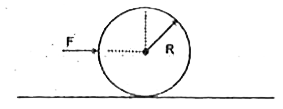A uniform cylinder is lying on a rough sheet of paper as shown in fig. The strip is pulled horizontally to the right with a constant acceleration of . Initially the cylinder is located at a distance of from the left end of the strip. Find the velocity of the centre of the cylinder at the instant it moves off the edge of the strip. Assume that the cylinder does not slip.

The correct Answer is:
Step by step video, text & image solution for A uniform cylinder is lying on a rough sheet of paper as shown in fig. The strip is pulled horizontally to the right with a constant acceleration of a_(0) = 6 m//s^(2). Initially the cylinder is located at a distance of L = 10 m from the left end of the strip. Find the velocity of the centre of the cylinder at the instant it moves off the edge of the strip. Assume that the cylinder does not slip. by Physics experts to help you in doubts & scoring excellent marks in Class 11 exams.
Updated on:21/07/2023Topper's Solved these Questions
Similar Questions
A cylinder of mass m and radius R is kept on a rough surface after giving its centre a horizontal speed v0. Find the speed of the centre of the cylinder when it stops slipping.
View SolutionIn the figure the plank resting on two cylinders is horizontal. The plank is pulled to the right such that the centre of smaller cylinder moves with a constant velocity v. Friction is large enough to prevent slipping at all surfaces. Find-
(a) The velocity of the centre of larger cylinder.
(b) The ratio of accelerations of the points of contact of the two cylinders with the plank.

View Solution
Knowledge Check
Consider a cylinder of mass M resting on a rough horizontal rug that is pulled out from under it with acceleration 'a' perpendicular to the axis of the cylinder. What is Ffriction at point P? It is assumed that the cylinder does not slip.
 AMgBMaCMa2DMa3
AMgBMaCMa2DMa3A solid cylinder of mass M and radius R rolls from rest down a plane inclined at an angle θ to the horizontal. The velocity of the centre of mass of the cylinder after it has rolled down a distance d is :
A√23gdtanθB√gdtanθC√34gdsinθD√43gdsinθA uniform cylinder of mass m rests on two rough horizontal planks. A thread is wound on the cylinder. The hanging end of the thread is pulled vertically down with a constant force F
ASince horizontal acceleration is provided by the friction acting on the cylinder, its translation kinetic energy (12mv2) is equal to work done by this friction,BSince moment about instantaneous axis of rotation is produced by force F. kinetic energy (12Iω2) is equal to work done by F where I is moment of inertia about the instantaneous axis of rotation and ω is the-angular velocity.CSince cylinder is moving, energy is lost against friction.DWork done by F+ work done by friction on cylinder =totalKE of the cylinder.
Consider a cylinder of mass M resting on a rough horizontal rug that is pulled out from under it with acceleration 'a' perpendicular to the axis of the cylinder. What is Ffriction at point P ? It is assumed that the cylinder does not slip.

View SolutionThe area of the base of a right circular cylinder is 616cm2 and its height is 25cm. Find the volume of the cylinder.
View SolutionIn the arrangement shown in the fig, end A of the string is being pulled with a constant horizontal velocity of 6m/s. The block is free to slide on the horizontal surface and all string segments are horizontal. Find the velocity of point P on the thread.

View SolutionThe volume of a right circular cylinder is 2310m2 and diameter of base is 14 m, then find the curved surface area of the cylinder.
View SolutionA force F is applied horizontally on a cylinder in the line of centre as shown in the figure. The cylinder is on a rough surface of coefficient of fricition μ. The direction of the friction force acting on the cylinder will be

View Solution
